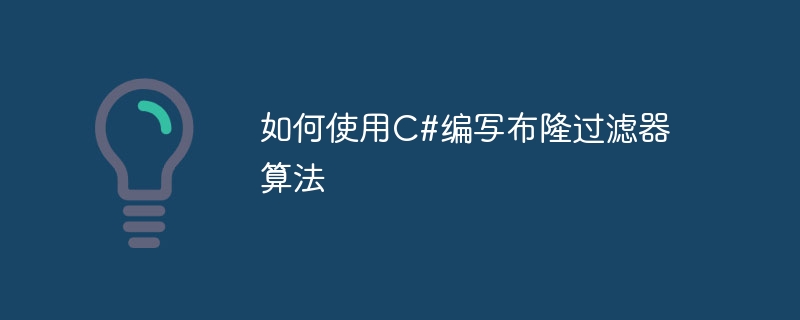如何使用C#編寫布隆過濾器演算法

如何使用C#來寫布隆過濾器演算法
布隆過濾器(Bloom Filter)是一種空間效率非常高的資料結構,可以用來判斷一個元素是否屬於集合。它的基本思想是透過多個獨立的雜湊函數將元素映射到一個位數組中,並將對應位數組的位元標記為1。當判斷一個元素是否屬於集合時,只需要判斷對應位數組的位是否都為1,如果有任何一位為0,則可以判定元素不在集合中。布隆過濾器具有快速查詢和佔用空間少的特點,在許多場景中都得到了廣泛應用。
本文將介紹如何使用C#撰寫布隆過濾器演算法,並提供具體的程式碼範例。
首先,我們需要定義一個布隆過濾器類,並宣告一些必要的變數和方法。以下是一個簡單的布隆過濾器類別的定義:
using System;
using System.Collections;
using System.Collections.Generic;
using System.Security.Cryptography;
public class BloomFilter
{
private BitArray _bits;
private int _hashFunctionsCount;
public BloomFilter(int capacity, double falsePositiveRate)
{
int bitsCount = GetBitsCount(capacity, falsePositiveRate);
_bits = new BitArray(bitsCount);
_hashFunctionsCount = GetHashFunctionsCount(bitsCount, capacity);
}
public void Add(string item)
{
foreach (int hash in GetHashes(item))
{
_bits.Set(Math.Abs(hash % _bits.Length), true);
}
}
public bool Contains(string item)
{
foreach (int hash in GetHashes(item))
{
if (!_bits[Math.Abs(hash % _bits.Length)])
{
return false;
}
}
return true;
}
private IEnumerable<int> GetHashes(string item)
{
using (SHA256 sha256 = SHA256.Create())
{
byte[] hashBytes = sha256.ComputeHash(System.Text.Encoding.UTF8.GetBytes(item));
for (int i = 0; i < _hashFunctionsCount; i++)
{
yield return BitConverter.ToInt32(hashBytes, i * 4);
}
}
}
private int GetBitsCount(int capacity, double falsePositiveRate)
{
return (int)Math.Ceiling(capacity * Math.Log(falsePositiveRate) / Math.Log(1 / Math.Pow(2, Math.Log(2))));
}
private int GetHashFunctionsCount(int bitsCount, int capacity)
{
return (int)Math.Round((double)(bitsCount / capacity) * Math.Log(2));
}
}以上程式碼定義了一個BloomFilter類,其中包含了建構子、Add方法和Contains方法。建構函數接收兩個參數:容量和誤判率,根據這兩個參數計算出所需的位數組大小和雜湊函數個數。 Add方法用於在布隆過濾器中新增元素,將元素透過多個雜湊函數對應到位元組中,並將對應位元組的位元標記為1。 Contains方法用於判斷一個元素是否存在於布隆過濾器中,透過多個雜湊函數將元素對應到位數組中,並判斷對應位數組的位元是否都為1。
接下來,我們可以使用布隆過濾器類別進行測試。以下是一個簡單的範例:
using System;
public class Program
{
public static void Main(string[] args)
{
BloomFilter bloomFilter = new BloomFilter(100000, 0.01);
bloomFilter.Add("apple");
bloomFilter.Add("banana");
bloomFilter.Add("orange");
Console.WriteLine(bloomFilter.Contains("apple")); // 输出:True
Console.WriteLine(bloomFilter.Contains("banana")); // 输出:True
Console.WriteLine(bloomFilter.Contains("orange")); // 输出:True
Console.WriteLine(bloomFilter.Contains("watermelon")); // 输出:False
}
}以上範例程式碼建立了一個布林過濾器對象,並在其中加入了三個元素("apple", "banana", "orange")。然後,透過Contains方法判斷一個元素是否存在於布隆過濾器中。
要注意的是,由於布隆過濾器存在一定的誤判率,因此在判斷一個元素是否在布隆過濾器中時,可能會發生誤判的情況。所以,布隆過濾器主要適用於那些可以容忍一定誤判率的場景,例如判斷一個URL是否已經訪問過等。
總結起來,本文介紹如何使用C#編寫布隆過濾器演算法,並提供了相關的程式碼範例。布隆過濾器作為一種高效的資料結構,在一些特定場景中具有重要的應用價值。希望本文能對理解和應用布隆過濾器演算法有所幫助。
以上是如何使用C#編寫布隆過濾器演算法的詳細內容。更多資訊請關注PHP中文網其他相關文章!

熱AI工具

Undresser.AI Undress
人工智慧驅動的應用程序,用於創建逼真的裸體照片

AI Clothes Remover
用於從照片中去除衣服的線上人工智慧工具。

Undress AI Tool
免費脫衣圖片

Clothoff.io
AI脫衣器

AI Hentai Generator
免費產生 AI 無盡。

熱門文章

熱工具

記事本++7.3.1
好用且免費的程式碼編輯器

SublimeText3漢化版
中文版,非常好用

禪工作室 13.0.1
強大的PHP整合開發環境

Dreamweaver CS6
視覺化網頁開發工具

SublimeText3 Mac版
神級程式碼編輯軟體(SublimeText3)

熱門話題
 如何使用C#編寫布隆過濾器演算法
Sep 21, 2023 am 10:24 AM
如何使用C#編寫布隆過濾器演算法
Sep 21, 2023 am 10:24 AM
如何使用C#編寫布林過濾器演算法布隆過濾器(BloomFilter)是一種空間效率非常高的資料結構,可以用來判斷一個元素是否屬於集合。它的基本思想是透過多個獨立的雜湊函數將元素映射到一個位數組中,並將對應位數組的位元標記為1。當判斷一個元素是否屬於集合時,只需要判斷對應位數組的位是否都為1,如果有任何一位為0,則可以判定元素不在集合中。布隆過濾器具有快速查詢和
 編寫C語言中計算冪函數的方法
Feb 19, 2024 pm 01:00 PM
編寫C語言中計算冪函數的方法
Feb 19, 2024 pm 01:00 PM
如何在C語言中編寫乘方函數乘方(exponentiation)是數學中常用的運算,表示將一個數自乘若干次的操作。在C語言中,我們可以透過寫一個乘方函數來實現這個函數。以下將詳細介紹如何在C語言中編寫乘方函數,並給出具體的程式碼範例。確定函數的輸入和輸出乘方函數的輸入通常包含兩個參數:底數(base)和指數(exponent),輸出為計算得到的結果。因此,我們
 如何使用C++編寫一個簡單的飯店預約系統?
Nov 03, 2023 am 11:54 AM
如何使用C++編寫一個簡單的飯店預約系統?
Nov 03, 2023 am 11:54 AM
飯店預訂系統是一種重要的資訊管理系統,它可以幫助飯店實現更有效率的管理和更良好的服務。如果你想學習如何使用C++來編寫一個簡單的飯店預訂系統,那麼這篇文章將為您提供一個基本的框架和詳細的實作步驟。飯店預訂系統的功能需求在開發飯店預訂系統之前,我們需要確定其實現的功能需求。一個基本的飯店預訂系統至少需要實現以下幾個功能:(1)客房資訊管理:包括客房類型、房間號碼、房
 如何使用C#撰寫動態規劃演算法
Sep 20, 2023 pm 04:03 PM
如何使用C#撰寫動態規劃演算法
Sep 20, 2023 pm 04:03 PM
如何使用C#撰寫動態規劃演算法摘要:動態規劃是求解最最佳化問題的常用演算法,適用於多種場景。本文將介紹如何使用C#編寫動態規劃演算法,並提供具體的程式碼範例。一、什麼是動態規劃演算法動態規劃(DynamicProgramming,簡稱DP)是一種用來求解具有重疊子問題和最優子結構性質的問題的演算法想法。動態規劃將問題分解成若干個子問題來求解,透過記錄每個子問題的解,
 如何使用C++寫一個簡單的學生選課系統?
Nov 02, 2023 am 10:54 AM
如何使用C++寫一個簡單的學生選課系統?
Nov 02, 2023 am 10:54 AM
如何使用C++寫一個簡單的學生選課系統?隨著科技的不斷發展,電腦程式設計成為了一種必備的技能。而在學習程式設計的過程中,一個簡單的學生選課系統可以幫助我們更好地理解和應用程式語言。在本文中,我們將介紹如何使用C++來寫一個簡單的學生選課系統。首先,我們需要先明確這個選課系統的功能和需求。一個基本的學生選課系統通常包含以下幾個部分:學生資訊管理、課程資訊管理、選
 如何透過C++寫一個簡單的掃雷遊戲?
Nov 02, 2023 am 11:24 AM
如何透過C++寫一個簡單的掃雷遊戲?
Nov 02, 2023 am 11:24 AM
如何透過C++寫一個簡單的掃雷遊戲?掃雷遊戲是一款經典的益智類遊戲,它要求玩家根據已知的雷區佈局,在沒有踩到地雷的情況下,揭示所有的方塊。在這篇文章中,我們將介紹如何使用C++來寫一個簡單的掃雷遊戲。首先,我們需要定義一個二維陣列來表示掃雷遊戲的地圖。數組中的每個元素可以是一個結構體,用於儲存方塊的狀態,例如是否揭示、是否有雷等資訊。另外,我們還需要定義
 如何用Python寫KNN演算法?
Sep 19, 2023 pm 01:18 PM
如何用Python寫KNN演算法?
Sep 19, 2023 pm 01:18 PM
如何用Python寫KNN演算法? KNN(K-NearestNeighbors,K近鄰演算法)是一種簡單而常用的分類演算法。它的思想是透過測量不同樣本之間的距離,將測試樣本分類到最近的K個鄰居。本文將介紹如何使用Python編寫並實作KNN演算法,並提供具體的程式碼範例。首先,我們需要準備一些數據。假設我們有一組二維的資料集,每個樣本都有兩個特徵。我們將資料集分
 如何使用C#寫二分查找演算法
Sep 19, 2023 pm 12:42 PM
如何使用C#寫二分查找演算法
Sep 19, 2023 pm 12:42 PM
如何使用C#編寫二分查找演算法二分查找演算法是一種高效率的查找演算法,它在有序數組中尋找特定元素的位置,時間複雜度為O(logN)。在C#中,我們可以透過以下幾個步驟來編寫二分查找演算法。步驟一:準備資料首先,我們需要準備一個已經排好序的陣列作為尋找的目標資料。假設我們要在陣列中尋找特定元素的位置。 int[]data={1,3,5,7,9,11,13






